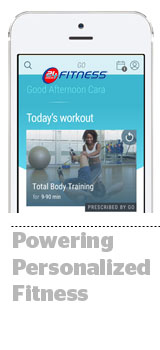
24 Hour Fitness is trying to transform into a brand that customers will consider even outside of the gym.
“The goal is to keep people engaged with fitness and to be this companion along their fitness journey,” said CMO Tom Lapcevic. “That’s where digital really enters the picture. We now have the ability to provide personalized guidance on a daily basis, regardless of where our members are. Fitness is no longer limited to our own four walls.”
That’s not to say 24 Hour Fitness has neglected the in-gym experience.
With more than 400 clubs in 13 states and 4 million members, the company has invested in its fitness facilities while simultaneously doubling down on data and tech – like its 24GO custom training app and My24 fitness app – to connect its digital and offline marketing approaches.
Lapcevic spoke with AdExchanger about how 24 Hour Fitness remains competitive in a digital age.
AdExchanger: How has 24 Hour Fitness evolved most as a brand?
TOM LAPCEVIC: One of the big challenges to get people started with fitness and to keep them on track is to help them understand what they need to do that’s unique to them. We try to help people satisfy their objectives based upon who they are, what the individual’s goals are, their current state of readiness and what they’re doing on a daily basis. Fitness can be intimidating if you don’t know what’s best for you.
How does your app 24GO help you better understand customers?
With 24GO, we essentially do a data input from the individual. They would complete a profile on their fitness goals, what kind of activities they do in the gym, what they do at home, what clubs they access because we have different amenity sets, or if they have a certain event they’re getting ready for.
We really have a holistic view of where someone is in their journey, their commitment level, their access to different apparatuses, and then we create a personalized program for them based upon that input. Biometrics, if they elect to do that, help us learn what’s working for that individual and their preferences, and we can perpetually customize their training and lifestyle regimen.
How does that impact how you market to them?
Oftentimes, life gets in the way of fitness. You plan to go to the club, but your child is sick or you have to stay late at work. 24GO will adapt to those lifestyle realities. It will know you were planning to come into the club or to take a certain class but couldn’t, and it’ll suggest an alternative activity you can do.
Can you give an example?
Certainly, we use traditional segmentation for a whole bunch of different applications, but what we’re striving for, using Adobe and Microsoft, is personalization. We have a lot of information relative to what our members want and what they’re trying to accomplish. In the past, we’d do a lot of research, but the challenge was that we’d have all this information and data, and it was really interesting, but it wasn’t actionable.
Not everyone can afford personal training, in the traditional sense, so technology allows us to create more personalization based on their specific goals and motivators. We’re at the beginning of that journey, but we’re seeing remarkable results when we can provide guidance at that level.
You’re using Adobe and Microsoft to do that. How?
With Microsoft, we used a lot of their platforms throughout our organization, including for our in-club kiosk, so it was a natural choice in addition to using what we think is best of breed.
With Adobe, we use a broad array of products from Adobe Campaign and the DMP Audience Manager to Experience Manager and Target. We build workout videos, articles and tips. One thing that led us to Adobe is that those were the platforms we used to build all this content to begin with.
That’s all being systematically integrated, so we can look at activities inside the club that we ingest through Dynamics [Microsoft’s CRM tool], into our data warehouse and data lake, or through Adobe.
How are you balancing new member acquisition vs. retention?
We used to try to bring people in with offers, but our goal now is to reach out and get people engaged with fitness.
We look at information we have where we can help people, deliver them workouts, improve their ability to work out at home with video and help them overcome the intimidation of fitness. So, our first goal is to help people get started with fitness, whether they come to us or a competitor. We send millions of communications per month with the primary goal of helping people get engaged with fitness, and we hope, from a business perspective, we help them progress.
What’s your top challenge?
We don’t lose members to competitive facilities. We lose them to inactivity. It’s why we’re so focused on each phase of the consumer journey. When people do join us, we need to onboard them in an appropriate way, and when they walk into our clubs, we push a personalized workout to them because we’ll know what amenities and services they’ll have access to within a specific facility. We also wanted to create a delivery vehicle of programming and content to keep them engaged.
This post was syndicated from Ad Exchanger.

More Stories
WBD Reveals First-Party Data Platform to Unify Buying Across Its Portfolio
The IAB Predicts Social Video Will Overtake CTV This Year
Best Buy and CNET Are Combining Their Ad Inventory